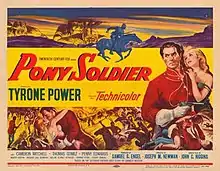Pony Soldier
Pony Soldier is a 1952 American Northern Western film set in Canada, but filmed in Sedona, Arizona. It is based on a 1951 Saturday Evening Post story "Mounted Patrol" by Garnett Weston. It was retitled MacDonald of the Canadian Mounties in Britain and The Last Arrow in France, Spain, and Italy.
| Pony Soldier | |
|---|---|
 Original film poster | |
| Directed by | Joseph M. Newman |
| Screenplay by | John C. Higgins |
| Based on | The Saturday Evening Post story by Garnett Weston |
| Produced by | Samuel G. Engel |
| Starring | Tyrone Power Cameron Mitchell Thomas Gomez Penny Edwards |
| Narrated by | Tyrone Power Michael Rennie (uncredited) |
| Cinematography | Harry Jackson |
| Edited by | John W. McCafferty |
| Music by | Alex North Alfred Newman (musical direction) |
| Color process | Technicolor |
Production company | 20th Century Fox |
| Distributed by | 20th Century Fox |
Release date |
|
Running time | 82 minutes |
| Country | United States |
| Language | English |
| Box office | $1.65 million (US rentals)[1] |
Plot
In 1876, the North-West Mounted Police send Constable Duncan MacDonald (Tyrone Power) and a blackmailed Blackfoot scout (Thomas Gomez) to get the Cree to sign Treaty 6 with the Crown. Initially hostile, the Cree are influenced by a Fata Morgana-type mirage that they mistake for the power of Queen Victoria.
In addition to negotiating with the Cree, MacDonald of the Mounted Police rescues White hostages (Robert Horton and Penny Edwards), arrests a murderer, and adopts a Cree son (Anthony Earl Numkena).
Cast
- Tyrone Power as Constable Duncan MacDonald
- Cameron Mitchell as Konah
- Thomas Gomez as Natayo Smith
- Penny Edwards as Emerald Neeley
- Robert Horton as Jess Calhoun
- Anthony Earl Numkena as Comes Running
- Adeline DeWalt Reynolds as White Moon
- Howard Petrie as Inspector Frazer
- Stuart Randall as Standing Bear
Included in the cast were Richard Boone and Frank deKova, with ending narration by Michael Rennie. Golden Globe-winning actor Earl Holliman made his film debut in this playing an uncredited role.[2]
Production
Director Newman originally scouted locations in Montana, but finding nothing he thought suitable, the film was made in Sedona, Arizona.[3] During development of the project, technical advisor on Native American issues, Nipo T. Strongheart, wrote a critical review of the proposed screenplay, though other departments of the studio had begun work on it. This led to a meeting with studio executives, which he described as feeling like he was called to the principal's office, and led to a major reconstruction of the whole project.[4][5] Strongheart worked with the Cree people and their language, and coached non-Indian and Indian actors throughout the movie. During the filming at Sedona, production was interrupted by snowstorms and the flash of a nuclear weapon tested 300 miles away in Nevada.[6] The producers recruited 450 Navajo to play Cree when large numbers were needed. Strongheart, who also plays a medicine man in the film, also toured to promote the movie.[4][7] Strongheart had appeared in the 1925 film Braveheart with Tyrone Power Sr.[4][7]
References
- 'Top Box-Office Hits of 1952', Variety, January 7, 1953
- "Earl Holliman Movies | FameMoose". Archived from the original on February 5, 2018. Retrieved February 5, 2018.
- "Sedona Monthly Magazine | Sedona Arizona art, restaurants, hiking and feature stories". Archived from the original on November 30, 2010. Retrieved January 8, 2010.
- Strongheart, Nipo T. (Autumn 1954). "History in Hollywood". The Wisconsin Magazine of History. 38 (1): 10–16, 41–46. JSTOR 4632754.
- Joanna Hearne (January 25, 2013). Native Recognition: Indigenous Cinema and the Western. SUNY Press. pp. 78, 107. ISBN 978-1-4384-4399-7.
- p.99 Heidinger, Lisa, Trevillyan, Janeen, Sedona Historical Society Sedona 2007 Arcadia Publishing
- "Film Actor works with Ty Jr, now". The Deseret News. Salt Lake City, Utah. August 31, 1952. p. 4. Retrieved August 25, 2014.